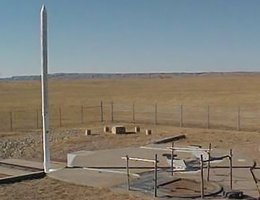

Life in Nebraska during the 1950s and 60s was determined, in large part, by what happened here during World War II. Life in the atomic age was really a legacy of the war.
For instance, nuclear scientists from Nebraska helped create the Atomic Age as part of the secret "Manhattan Project" that built the first A-bombs during World War II. The planes that dropped the first atomic bombs on Hiroshima and Nagasaki were built in Omaha. The air base where they were built, Offutt Air Base, became a pivotal part of the Cold War. Hundreds of airplanes with atomic bombs were stationed at Offutt during the Cold War under the command of SAC (the Strategic Air Command). The command controlled thousands of other airplanes, submarines and atomic missiles around the world. Some of those missiles were housed in underground silos all across Nebraska. Most of these missiles and bombs were pointed at the Soviet Union.
The fact that there were atomic bombs based in Nebraska meant that there were undoubtedly scores of Soviet bombers, and later missiles, pointed at Nebraska. If an all-out nuclear war had erupted, atomic bombs would have rained down on the state. That fact changed the lives of people living in Nebraska.
Early in the Atomic Age, the government tried to find ways that civilians could possibly survive an atomic attack. Former Nebraska Governor Val Peterson was put in charge of the Federal Civil Defense effort. During his administration the new hydrogen fusion bomb, or Superbomb, was developed. Testing of the H-bomb showed that radioactive particles would travel far from the blast area. Peterson realized that the plans in place at the time wouldn’t work. He came up with plans to evacuate city target areas.
But there were also peaceful affects of the atomic age on Nebraska. One of the first atomic-powered electric generating stations was built near Hallam, outside of Lincoln. This was an experimental plant. It was in service for only two years, and was the first commercial atomic energy plant to be taken out of service or "decommissioned". The highly radioactive nuclear material was shipped to a storage facility. Some nuclear material and parts of the plant were used by other plants. What was left — pipes and equipment that had been exposed to radiation — was sealed up in the reactor containment vessel, surrounded by concrete and buried alongside the generating station. The reactor was replaced by a conventional, coal-fired boiler and the plant is still producing electricity. It’s known at the Sheldon Station.
The Interstate Highway across the state was also a product of the atomic age. Behlen Manufacturing Company in Columbus got a great marketing boost when one of its steel buildings survived an atomic bomb test. And Nebraska was the site of one of the nation’s first protests against the A-bomb race and nuclear war.